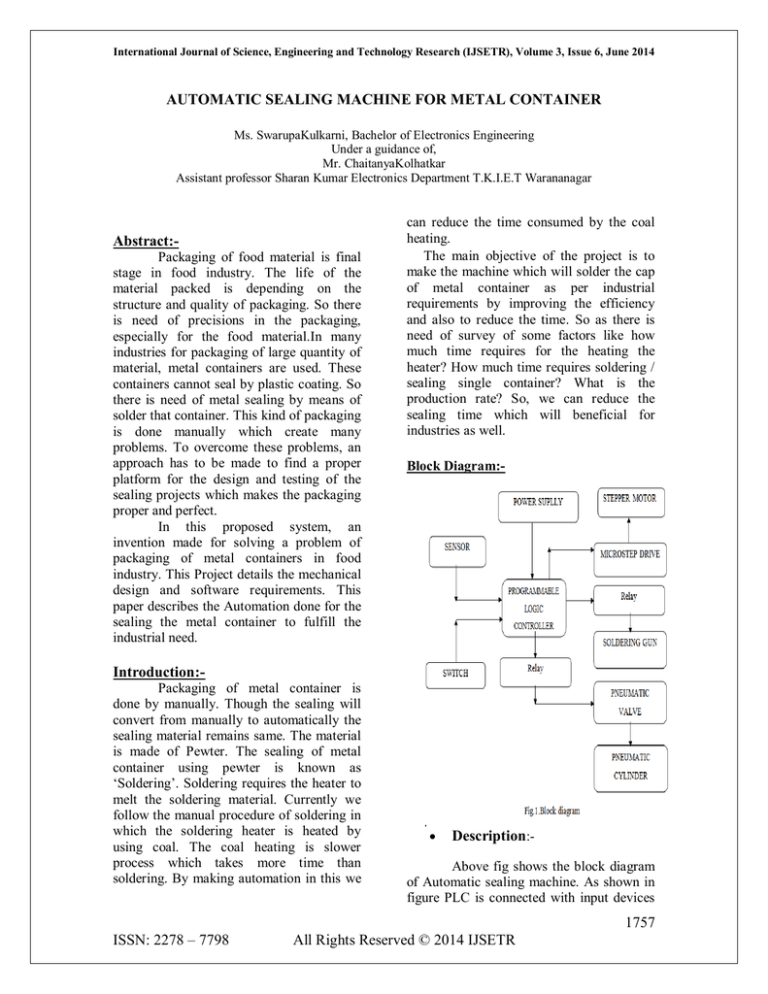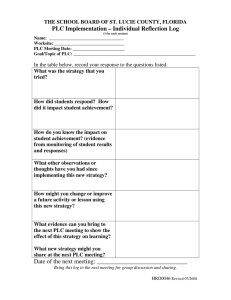
International Journal of Science, Engineering and Technology Research (IJSETR), Volume 3, Issue 6, June 2014
AUTOMATIC SEALING MACHINE FOR METAL CONTAINER
Ms. SwarupaKulkarni, Bachelor of Electronics Engineering
Under a guidance of,
Mr. ChaitanyaKolhatkar
Assistant professor Sharan Kumar Electronics Department T.K.I.E.T Warananagar
Abstract:Packaging of food material is final
stage in food industry. The life of the
material packed is depending on the
structure and quality of packaging. So there
is need of precisions in the packaging,
especially for the food material.In many
industries for packaging of large quantity of
material, metal containers are used. These
containers cannot seal by plastic coating. So
there is need of metal sealing by means of
solder that container. This kind of packaging
is done manually which create many
problems. To overcome these problems, an
approach has to be made to find a proper
platform for the design and testing of the
sealing projects which makes the packaging
proper and perfect.
In this proposed system, an
invention made for solving a problem of
packaging of metal containers in food
industry. This Project details the mechanical
design and software requirements. This
paper describes the Automation done for the
sealing the metal container to fulfill the
industrial need.
can reduce the time consumed by the coal
heating.
The main objective of the project is to
make the machine which will solder the cap
of metal container as per industrial
requirements by improving the efficiency
and also to reduce the time. So as there is
need of survey of some factors like how
much time requires for the heating the
heater? How much time requires soldering /
sealing single container? What is the
production rate? So, we can reduce the
sealing time which will beneficial for
industries as well.
Block Diagram:-
Introduction:Packaging of metal container is
done by manually. Though the sealing will
convert from manually to automatically the
sealing material remains same. The material
is made of Pewter. The sealing of metal
container using pewter is known as
‘Soldering’. Soldering requires the heater to
melt the soldering material. Currently we
follow the manual procedure of soldering in
which the soldering heater is heated by
using coal. The coal heating is slower
process which takes more time than
soldering. By making automation in this we
Description:-
Above fig shows the block diagram
of Automatic sealing machine. As shown in
figure PLC is connected with input devices
1757
ISSN: 2278 – 7798
All Rights Reserved © 2014 IJSETR
International Journal of Science, Engineering and Technology Research (IJSETR), Volume 3, Issue 6, June 2014
and with output devices in different ports.
For the input devices there is no need of
consideration of the device type like NPN or
PNP. We can connect any of them.
The input devices we can connect
to PLC are switches, sensors. Similarly
output devices are valves, motors (stepper,
dc motors), relays etc.
Mostly for connecting valve, DC
motors there is need of connecting the relay,
so as to perform the switching operation.
But as shown above for stepper motor we
require a driver to communicate with PLC.
All devices shown in above block
diagram, operates on the 24V DC voltage.
The total current required for system is
about 3.5amp.
Manufacturing:
Hardware
Working of PLC:Input signal:
PLC reads the ON/OFF status of each
input and stores the status into memory
before evaluating the user program. Once
the external input status is stored into
internal memory, any change at the external
inputs will not be updated until next scan
cycle starts.
Program:
PLC executes instructions in user
program from top to down and left to right
then stores the evaluated data into internal
memory. Some of this memory is latched.
Output:
When END command is reached the
program evaluation is complete. The output
memory is transferred to the external
physical outputs.
The hardware used in this proposed
work is listed below:
SrNo. Name of Device
1. Switched Mode Power Supply (SMPS)
2. Programmable Logic Controller(PLC)
3. Sensor
4. Micro step Driver
5. Stepper Motor
6. Pneumatic Valve
Fig2. Programmable Logic Controller
7. Pneumatic Cylinder
8. Gear- Bevel Gear
Programmable Logic Controller
(PLC):This is the main part of this design.
It is programmable hardware which controls
all other hardware’s operations.
The PLC used is of manufacturer DELTA.
The model name is DVP12SA211T having 8
inputs and 4 outputs. This PLC is NPN type
PLC. Gives output of 0V with respect to
24V supply. As this model is of transistor
type PLC, the Transistors are used both at
input and output ports internally.
As transistorized device is used here,
when the base current goes high then
switching is perform. This is simplest than
using relay at every ports. So that whole
1758
ISSN: 2278 – 7798
All Rights Reserved © 2014 IJSETR
International Journal of Science, Engineering and Technology Research (IJSETR), Volume 3, Issue 6, June 2014
system got the reduced size and less
complexity.
This device requires 24V DC supply
carries current of 1amp. Also supports all
devices operating on 24V DC supply.
.
This software supports all Delta
PLC. Programmer can program in three
languages viz. Ladder logic, Sequential
Flow and Instruction Set.
Software:IEC 61131-3 standard
IEC 1131-3 is the international standard for
programmable controller programming
languages. The following is a list of
programming languages specified by this
standard:
Ladder diagram (LD)
Sequential Function Charts (SFC)
Function Block Diagram (FBD)
Structured Text (ST)
Instruction List (IL)
One of the primary benefits of the standard
is that it allows multiple languages to be
used within the same programmable
controller. This allows the program
developer to select the language best suited
to each particular task.
Software Used in Proposed System:-
1759
ISSN: 2278 – 7798
All Rights Reserved © 2014 IJSETR
International Journal of Science, Engineering and Technology Research (IJSETR), Volume 3, Issue 6, June 2014
Experimentation:
Description:As per requirement of sealing
pattern above flow is designed. Here
soldering gun is switched by considering
the production rate. One counter is used
for counting the objects, which is further
used for switching soldering gun. As for
controlling the rotation of soldering gun
with respect to angle, the stepper motor
is used. Pulses to stepper motor are
given by driver, controlled by PLC.
Pressure to pneumatic cylinder is
given by solenoid valve.
Interfacing Diagram:-
s/s is input supply for input devices.
If input devices are NPN then s/s acts as
sink mode, s/s= +24V is needed for sink
mode.
If input devices are PNP then s/s acts as
source mode. Then s/s is neede to be ground.
Simillary, UP and ZP acts as output
supply for output devices. But unlike s/s, for
UP and ZP the supply configuration is fixed.
Means for NPN PLC user can operate only
NPN output devices.
1760
ISSN: 2278 – 7798
All Rights Reserved © 2014 IJSETR
International Journal of Science, Engineering and Technology Research (IJSETR), Volume 3, Issue 6, June 2014
Typical connection of Stepper Motor with
Driver
Hardware Setup:-
Pneumatic cylinder
Stepper motor
As stepper motor is controlled by
PLC by means of Driver, there is need of
proper connections. While doing connection,
the connectivity between coils of stepper
motor must be check. For changing the
direction of rotation the direction port is
available.
Gear
Sequence chart of control signal:Container
Above experimental setup of
Automatic Sealing Machine. The metal
container is detected by sensor. Pneumatic
cylinder is used to move gear and motor
system up and down while removing and
placing the container on the perticular space.
1761
ISSN: 2278 – 7798
All Rights Reserved © 2014 IJSETR
International Journal of Science, Engineering and Technology Research (IJSETR), Volume 3, Issue 6, June 2014
[1]. IEC International Standard 1131-3,
Programmable
Controllers,
Part
3,
Programming Languages, 1993
Program inLadder Logic:-
[2]. R.W. Lewis, Programming industrial
control systems using IEC 1131-3, The
Institution of Electrical Engineers, 1995
[3]. O. Maler, S. Yovine, Hardware timing
veri_cation using kronos, in: Proc. 7th Conf.
on Computer-basedSystems and Software
Engineering, IEEE Press, New York, 1996.
[4].H. Dierks, Synthesising controllers from
real-time
specifications,
in:
10th
Internat.Symp.On System Synthesis, IEEE
Computer Society, New York, September
1997, pp. 126{133, short version of [11].
[5]. J. Tapken, Interactive and compilative
simulation of PLC-Automata, in: W. Hahn,
A. Lehmann (Eds.), ESS'97, SCS, October
1997, pp. 552-556.
[6]. I.L. Krivts, "Pneumatic actuator with
constant velocity mode in reciprocating
motion", Int. J. Fluid Power, vol. 9, no. 1,
pp. 9-15,2008.
Applications:As for solving an industrial
problem this project has been designed,
there is need of see that whether this
solution worked or not. By performing
experimentation, it is observed that this
model works as per designed. Automation is
basically used for reducing man power and
improving efficiency. This project exactly
proves the use of automation gives
tremendous results. Not only time efficient,
also saves lots of power as all devices are
operating on 24V power supply DC. Also
this is analyzed that only one time
investment gives long life application with
minimum maintenance.
References:-
[7]. G. Junzhong, Y. Junping, "Simulation
analysis of pneumatic on-off pressure
mechanism on printing press", In: 2010
InternationalConference on Advances in
Materials and ManufacturingProcesses,
2010, pp. 1481-1484.
[8]. M. Muntaser, A. Mohammed, I. AlKhawaldeh and H. Al-Mujafet, "Pneumatic,
PLC controlled, automotive gear shifting
mechanism", Res. J. Appl. Sci. Eng.
Technol., vol. 2, no. 3, pp. 245-251
[9]. S. Xiao-Ming, L. Lei, and X. Yun-Qing,
"Automatic
placing
and
removing
manipulator of the workpiece on stretcher
based on electric-pneumatic control and
PLC
control",
In:
6th
ChinaJapanInternational
Conference
on
Mechatronics, 2010, pp. 5-8.
1762
ISSN: 2278 – 7798
All Rights Reserved © 2014 IJSETR
International Journal of Science, Engineering and Technology Research (IJSETR), Volume 3, Issue 6, June 2014
[10]. Pressman, Abraham I. (1998),
Switching Power Supply Design (2nd ed.),
McGraw-Hill, ISBN 0-07-052236-7
[11]. PLC-automata: a new class of
implementable real-time automata Henning
Dierks 1
University of Oldenburg,
FachbereichInformatik, Postfach 2503, 2900
Oldenburg, Germany
[12].
INTRODUCTION
TO
PLC
Programming- Gary Dunning 2nd Edition,
THOMSON publication.
[13]. I.L. Krivts, "Pneumatic actuator with
constant velocity mode in reciprocating
motion", Int. J. Fluid Power, vol. 9, no. 1,
pp. 9-15,2008.
[14]. J. ´Swider, et al., "Programmable
controller designed for electro-pneumatic
systems”, Journal of Material Processing
Technology, pp. 145-14652005
[15]. International Journal of Engineering
Trends and Technology- Volume4Issue32013 ISSN: 2231-538Page 500 The
Principle of Programmable Logic Controller
and its role in Automation Avvaru Ravi
Kiran#1,
B.VenkatSundeep*2,
Ch.
SreeVardhan
#3,
Neel
Mathews!4
#Electronics and Communications, KL
University, Guntur, Andhra Pradesh,
India *Assistant Professor, Electronics
and Communications, KL University,
Guntur, Andhra Pradesh, India ! General
Manager Mobility Solutions, Mahindra
Reva Electric Vehicles Pvt Ltd,
Bangalore, India
1763
ISSN: 2278 – 7798
All Rights Reserved © 2014 IJSETR

